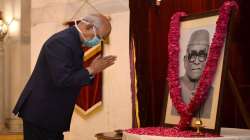President election: Only President who was elected unopposed in Independent India | Check
Over the years, the rules of the presidential elections have also been amended to keep out non-serious candidates, without even a remote chance of getting elected, entering the fray.

President election: We will know by afternoon today who will succeed incumbent Ram Nath Kovind to become India's 15th President. Ruling NDA's Droupadi Murmu and Opposition's Yashwant Sinha are pitted against each other in the contest, with votes clearly stacked in favour of Murmu, who, if elected, will be the first tribal woman to occupy the top constitutional post in the country.
But do you know that India's seventh president Neelam Sanjiva Reddy was the only one to be elected unopposed to the post in the history of independent India?
A deep dive into this historic moment
Neelam Sanjiva Reddy succeeded Fakruddin Ali Ahmed after his death in 1977. Ahmed breathed his last on February 11, 1977, a day after the Lok Sabha polls had commenced following two years of Emergency. Vice President B D Jatti had assumed office as acting President. Elections to 11 state assemblies were also scheduled between June-July the same year and the presidential election was notified only on July 4.
Ironically, the electoral college comprising 524 newly-elected Lok Sabha members, 232 Rajya Sabha members, and legislators from 22 state assemblies, did not have to cast their votes in the presidential poll as Reddy was the only candidate left in the fray as nomination papers of 36 other aspirants were rejected.
While the 1977 poll was held amid unusual circumstances, the most interesting election was in 1969 when Reddy, the official candidate of the Congress, was defeated by Varaha Venkat Giri when the then prime Minister Indira Gandhi called for a "conscience vote" in her bid to trump her detractors within the party.
Rules of presidential elections have been amended from time to time
Over the years, the rules of the presidential elections have also been amended to keep out non-serious candidates, without even a remote chance of getting elected, entering the fray.
People approached courts of law challenging election to the office of president
Another matter of concern was the manner in which some persons approached courts of law challenging the election to the office of the president.
Accordingly, it was made mandatory for any prospective presidential candidate to get his or her nomination paper subscribed by at least 50 electors as proposers and at least 50 electors as seconders.
Also Read | President Election 2022 Result: Droupadi Murmu or Yashwant Sinha? Who will be India's 15th President?
Since the first presidential election in 1952...
In the first presidential election in 1952, which Rajendra Prasad won, there were five contesting candidates with the last one getting only 533 votes.
The second election in 1957, which was also won by Prasad, had three contesting candidates. The third election also saw only three contestants, but the fourth election in 1967 saw as many as 17 contestants with nine getting zero votes and five getting less than 1,000 votes. In comparison, the winner of the 1967 election, Zakir Hussain, secured more than 4.7 lakh votes.
The fifth election had 15 contestants with five failing to secure even a single vote. This election in 1969 had many firsts, including strict secrecy of voting and allowing some MLAs to cast their votes at Parliament House in New Delhi instead of their state capitals. At that time, the decision to have a gap of four days between the date of the poll and the date of counting faced some criticism. Some critics had also said the votes should have been counted at the state capitals themselves instead of being brought to Delhi. It was for the sixth election in 1974 when the Election Commission first decided to introduce several measures to discourage non-serious candidates. The election had only two contestants.
For the seventh election in 1977, total of 37 candidates filed their nominations. On scrutiny, the returning officer rejected the nominations filed by 36 candidates and only one validly nominated candidate remained in the field, Reddy. Neither the preparation nor publication of the list of contesting candidates for taking the poll therefore became necessary and Reddy was declared elected unopposed after the last date of withdrawal.
The eighth presidential election in 1982 saw two contestants, while the ninth election in 1987 had three. The 1987 election also witnessed one candidate, Mithelesh Kumar Sinha, who eventually came third with 2,223 votes, requesting the Commission for facility to put forth his views over AIR/Doordarshan. Under a scheme evolved by the Ministry of Information and Broadcasting, in consultation with the Election Commission in 1977, such broadcasting or telecasting facilities are afforded to recognized political parties during general elections to Lok Sabha and state assemblies.
However, these facilities are not extended to other elections.
Another candidate V R Krishna Iyer also reportedly had requested the Minister of State for Information & Broadcasting Ajit Kumar Panja that the three contesting candidates should be given the opportunity to express their views over AIR/Doordarshan. But, the government reportedly did not accept the request and accordingly no candidate was allowed the facility of broadcasting/telecasting their views.
The 10th election in 1992 had four contestants, Ram Jethmalani (2,704 votes, third place) and Kaka Joginder Singh Urf Dharti-Pakad (1,135 votes, fourth place). There have been only two contestants since the 11th presidential election held in 1997, when the security deposit and the numbers of proposers and seconders were increased significantly.
(PTI Inputs)
Also Read | President Election 2022: Anupam Kher declares Droupadi Murmu as the next President of India